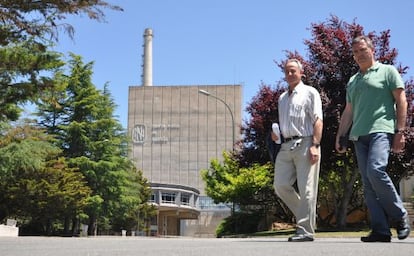Nervous wait for community that revolves around nuclear power
Garoña plant being wound down by owners but government may intervene


Towns in the Merindades region of Burgos, in northern Spain, say that they have no Plan B to deal with the impact of last week's closure of the Garoña nuclear plant. Not that they can be accused of sitting on their hands.
"We have been trying for the last three years to get the resources we need, so that if the closure goes ahead, it doesn't affect people too dramatically. But the truth of the matter is that we have no alternative so far," says Rafael González Mediavilla, the Mayor of Tobalina, the nearest village to the Garoña plant. Of the village's 1,000 inhabitants, some 30 families depend on the power station, while another 15 are indirectly employed by it.
"In 2009 [when the previous Socialist Party administration set July 6, 2013 as the date for Garoña's closure], there was one meeting to discuss the issue. And nothing was done after that," says González.
In Traspaderne, 20 kilometers from Garoña, Alfonso Zorilla is serving drinks and food at the Fontana café, a family business that has been hard hit since visits to the power plant were canceled. In 2012, more than 12,000 people toured Garoña. "The excursions were a big part of our business. After the visit, the bus would stop off here. There are people whose livelihoods depend on the power plant," he adds. His father, now retired, worked at Garoña for almost 30 years.
The truth of the matter is that we have no alternative to the plant"
The village is home to several dozen employees at the plant, but not everybody in the community is unhappy that Garoña is slated for closure. The Coordinating Committee Against Garoña has organized a talk by nuclear physicist Paco Castejón, and has arranged a demonstration in support of the shutdown.
Five tourists are sitting outside a bar in the village square drinking beer. The waiter attending them says that Garoña has not had that big an impact on the local economy: "Most of my customers want the place closed as soon as possible."
"When I was 10, my father took me to see the reactor. At that time, in the 1970s, the best welders and boilermakers all came to this area, including American engineers. This was a very fashionable place," says a gardener who believes that the time has come to shut Garoña down. More than 60 percent of the workforce lives in nearby Miranda de Ebro. The buses that cover the 30-kilometer journey have fewer and fewer passengers.
Miranda de Ebro's Las Matillas district was built at this time to house many of those working at Garoña. The area boasts large, spacious houses with gardens, and used to be known as the American neighborhood, although many of Garoña's workforce have moved out. Some locals say that plant employees were given free electricity; in reality they enjoyed significant discounts.
The companies are blackmailing the government with us as hostages"
The Hotel Tudanca, close to Las Matillas, has seen revenue drop by around 15,000 euros since December. "Overall, losses throughout the area could be more than a million euros," says the hotel's manager.
Some locals accuse the electricity companies of using Garoña to blackmail the government; "With us as the hostages," says one.
In a report from late last year, the Burgos College of Economists is critical of the plan drawn up in 2009, as Garoña approached the end of its life cycle. The study highlights the lack of "realistic and specific" options to revive the local economy.
In 2011, Garoña contributed directly and indirectly to generating some 239 million euros, according to consultancy AFI.
On July 6, Garona's 42-year life was officially supposed to end. But its continued operation cannot be ruled out. The government argues that Endesa and Iberdrola (who each have a 50-percent stake in the plant) have pulled the plug for financial reasons, and not because of safety issues. The administration may yet issue a decree that would extend the plant's operating life by another year. In the meantime, Garoña's 281 workers continue to carry out maintenance work. Around half of the 463 employees working for subcontractors have already been fired.
But the wait is creating tensions among the workforce despite Garona's management company, Nuclenor, assuring them that in the event of a definitive closure, it will find them employment in other power plants.
"If the plant closes, we'll have to go, because there is nothing else round here. Local businesses are very worried, because the impact of the closure would be huge," says Francisco Gutiérrez, an electrician who has worked at Garoña since 1988, and who says that the plant could run for another 15 or 20 years.
Tu suscripción se está usando en otro dispositivo
¿Quieres añadir otro usuario a tu suscripción?
Si continúas leyendo en este dispositivo, no se podrá leer en el otro.
FlechaTu suscripción se está usando en otro dispositivo y solo puedes acceder a EL PAÍS desde un dispositivo a la vez.
Si quieres compartir tu cuenta, cambia tu suscripción a la modalidad Premium, así podrás añadir otro usuario. Cada uno accederá con su propia cuenta de email, lo que os permitirá personalizar vuestra experiencia en EL PAÍS.
¿Tienes una suscripción de empresa? Accede aquí para contratar más cuentas.
En el caso de no saber quién está usando tu cuenta, te recomendamos cambiar tu contraseña aquí.
Si decides continuar compartiendo tu cuenta, este mensaje se mostrará en tu dispositivo y en el de la otra persona que está usando tu cuenta de forma indefinida, afectando a tu experiencia de lectura. Puedes consultar aquí los términos y condiciones de la suscripción digital.
More information
Últimas noticias
Most viewed
- Alain Aspect, Nobel laureate in physics: ‘Einstein was so smart that he would have had to recognize quantum entanglement’
- Maps of the US attack on Venezuela: Targets, airspace and deployed fleet
- Oil, gold and rare earth elements: the backdrop to US political tension with Venezuela
- Key points of the military attack on Venezuela: Early morning bombings and a ‘captured’ president
- The US bombing of Venezuela, in pictures









































